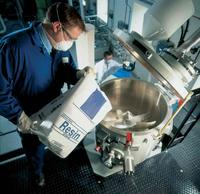 Before PVC can be made into products, it has to be combined with a range of special additives. The essential additives for all PVC materials are stabilisers and lubricants; in the case of flexible PVC, plasticisers are also incorporated. Other additives which may be used include fillers, processing aids, impact modifiers and pigments. Additives will influence or determine the mechanical properties, light and thermal stability, colour, clarity and electrical properties of the product. Once the additives have been selected, they are mixed with the polymer in a process called compounding. One method uses an intensive high-speed mixer that intimately blends all the ingredients. The result is a powder, known as a ‘dry blend’, which is then fed into the processing equipment.
Before PVC can be made into products, it has to be combined with a range of special additives. The essential additives for all PVC materials are stabilisers and lubricants; in the case of flexible PVC, plasticisers are also incorporated. Other additives which may be used include fillers, processing aids, impact modifiers and pigments. Additives will influence or determine the mechanical properties, light and thermal stability, colour, clarity and electrical properties of the product. Once the additives have been selected, they are mixed with the polymer in a process called compounding. One method uses an intensive high-speed mixer that intimately blends all the ingredients. The result is a powder, known as a ‘dry blend’, which is then fed into the processing equipment.
The second method is to blend the ingredients in either a low or high-speed mixer and then transfer the powder to a melt compounder. This can either be a compounding extruder, or other special equipment for making PVC compounds. These produce a melt which, when cool, is cut into granules ready for processing. In a specialised process, liquid compounds known as plastisols, are produced as dispersions of very fine PVC polymer particles in liquid organic media. PVC compounds are made into products using a variety of processing methods which include extrusion, injection moulding, blow moulding, calendering, spreading and coating.






Get Social